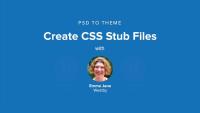It's pretty typical for a site to have one or two pieces of content that need to be easily edited, but also aren't nodes. For example: text in the footer. There are a number of ways to create this content. We'll use blocks to create this content as this is the easiest way to place content into a specific region without additional helper module. By the end of this lesson you will be able to create custom blocks, and place them into specific regions within your Drupal theme.
A base theme is someone's idea of a really great starting point. It might include the stub files for CSS overrides, template files which bring Drupal core's markup up-to-date with HTML5, useful theme overrides which create new template variables. In other words: a base theme can provide you with a lot of really great stuff! The first version of the Domicile Theme used the NineSixty base theme—just enough for a simple site, but not so much overhead that it was complicated to learn. This version of the theme doesn't use a base theme. That's because, thanks to Sass, we'll be able to get almost all of the power of the NineSixty base theme through a gem plug-in. In this lesson you will learn which folders are typically used to keep Drupal themes neat and tidy.
This week, we continue the journey from PSD to Drupal Theme as Emma Jane Westby shows us how to prepare a Drupal site for our theme by generating sample content, customizing image styles, creating and placing blocks, and creating a useful
If you’re anything like me, you’ve been meaning to get involved with Drupal 8 for quite some time now. But where to start? What’s left to be done? How do I find tasks that match my skills? Enter Core contribution mentoring.
Careful With That Debug Syntax
Blog postA funny thing happened last week. On Wednesday, we performed our weekly code deployment and released a handful of new features/bug fixes to the site. And then, about an hour later, someone on the team found this:
Contributing Time to Drupal 8
Blog postDrupal 8 is coming in 2014. There is a lot of work to do and a lot to learn. We've decided to dedicate a minimum of five hours per week towards Drupal 8 for each person on the Drupalize.Me team.
This week we're chugging along with our PSD to Drupal Theme series, with a look at getting our CSS system setup and figuring out our Drupal elements for theming.
Free PSD to Theme Webinar
Blog postIn 2008 I started on my big Drupal theming adventure by co-authoring Front End Drupal with Konstantin Käfer. Since that time thousands of people have learned Drupal theming through this book, and my presentations and workshops.
A Few Bug Fixes
Blog postWe're super excited to release a new series this week, which has been a highly requested one on our suggestion list: PSD to Drupal Theme. This series walks you through the process of converting a static design into a Drupal theme. We'll be covering strategies for breaking down your design into Drupal pieces, extracting your design assets, and working with those components in your CSS. Along the way you're going to also be introduced to grid frameworks, Sass, and other very helpful general web development tools. At the end you will have a theme that you can install and enable on your Drupal site. Having a little bit of Drupal site building experience, and a little bit of Web experience (HTML and CSS) will be helpful but it's not required, so if you find the world of Drupal themes mysterious, this is a great series to clear the fog.
This learning series covered just the tip of the theming iceberg. Hopefully you're now feeling motivated to learn even more about theming. In this lesson we will review some of the other topics you will want to explore next including: advanced theming techniques, using a base theme, such as Omega, layout modules. By the end of this lesson you will by able to identify which videos you should (or could) watch next to learn more about theming Drupal.
To go from design to theme we worked through three major steps: building a style guide; building out Drupal; and finally applying the style guide to Drupal. In this lesson we'll review each of the steps outlined in this learning series:
- creating a style guide with base rules, layout rules, and component rules
- extracting design assets
- configuring Drupal
- creating theme files
- debugging components from within Drupal
By the end of this lesson you will be able to outline the process needed to transform a static design file into a functional Drupal theme.
Once all of the elements are in place, it's time to get down to the real work of theming the components. In this lesson we will:
- use our style guide and checklist to find each component
- check to see if the style looks "right"
- troubleshoot broken styles so that each component looks as good as the designer's original, static files
By the end of this lesson you will be able to identify elements on a rendered Drupal page which do not have the correct styles applied, determine the source of the problem, and alter the markup or styles to correct the output displayed in a browser.
Once your theme is uploaded you still need to enable it before it will be applied to your site. By the end of this lesson you will be able to enable new themes for your Drupal site.
It's always smart to do your development work in a local environment, but eventually you will need to upload your theme your server. In this lesson we'll upload our theme to our web server using Filezilla. By the end of this lesson you will know which folder your theme needs to be uploaded to, and at least one application suitable for uploading files.
Additional resources
The final step before we step back into Drupal is to create a checklist for all the things we need to implement in Drupal. Using our style guide as a starting point, we'll ensure that every design decision which has been made can be implemented in Drupal. Your checklist might also include notes about which modules should be used to build each of the components from within Drupal. Creating a checklist might seem like a trivial task, but it's really important that you know exactly what you're about to build so that you don't get overwhelmed once you step into Drupal. By the end of this lesson you should be able to create a document with all the instructions, and notes you will need to apply your style guide to a Drupal site.
In SMACSS there are both major and minor layout rules that need to be created. The major layout rules are often handled by a grid framework and are used to describe big areas on your site, such as your Drupal regions. The minor rules are used for the components (for example how a picture aligns next to a paragraph of text). In this lesson we'll start by review how Sass allows us to use semantic naming for our CSS layout classes. Then we'll adapt the sample Sass provided by the 960 Compass Plugin so that it uses the necessary structure for our design.
By the end of this lesson, you will be able to implement the layout rules from your style guide as a Sass file using the 960 Compass Plugin as a reference.
Additional resources
In this lesson we will convert the style guide into a series of stubs which we can view in a Web browser. The design was originally created using the templates from the 960gs. We'll use this same grid framework to ensure all of our margins are automatically adopted. Grid frameworks are excellent for rapid prototyping of designs. Ultimately many front end developers choose choose to write their own for the final theme; however, if you're just getting started try to stick with a grid framework to reduce the number of things that you need to fight with.
The original theme that was created for this design used the NineSixty base theme. There are some nifty features in this theme which are great for more complex designs; however, it is not responsive, and does not use Sass. To bring the lessons up-to-date we'll be using the 960-Compass Plugin to generate our stub files and give us some sample Sass output to work with.
By the end of this lesson you will be able to convert a style guide to a series of stub files in Sass (or CSS) using SMACSS conventions and a grid framework.
Additional resources
SMACSS (Scalable and Modular Architecture for CSS)
In the previous lesson you created a text-based style guide. It's now time to extract the necessary assets from our static design for use in our theme. To complete this lesson you will need a design application capable of opening a .psd file. The video demonstrates Photoshop, but I typically use Gimp. Either is fine. And if you don't have a graphics program, you can watch the video, but simply download the assets which were extracted during the lesson. By the end of this lesson you will be able to identify page-level design assets which need to be extracted from a design file for your Drupal theme.
Additional resources
Over the last couple of years we've seen the rise of object oriented CSS. There's been a lot of work done by smart folks to categorize different types of rules that we use to style our sites. We're going to take advantage of this work and use it to create a style guide. This foundation piece will help us to map the elements in our static design to the elements that we will build, and theme, in Drupal.In this lesson we'll create a style guide from our design with:
- Base rules
- Layout rules
- Component rules
By the end of this lesson you will be able to create a text-based style guide of your design which accurately describes your site according to base rules, layout rules, and component rules. You will be able to further supplement this style guide by adding relevant images which reference the exact component the style guide is describing.











